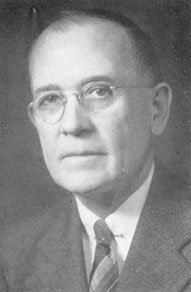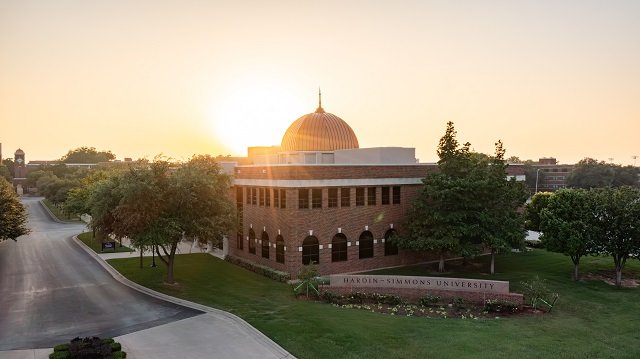George S. Anderson
HSU Trustee 1903-1964
 George S. Anderson was born on October 18, 1871, in Salado, Texas, the fourth of seven children to Captain Vachel and Malvina Anderson. He attended primary grades at Salado College, a private school in Bell County, Texas, where he absorbed early Texas civilization and culture. In December 1885, at the age of 15, George traveled with his father and older brother in a covered wagon to Fisher County, leaving the remainder of the family at their home in Bell County to follow in March 1886. George’s father was a partner in the establishment of the town of Roby in Fisher County.
George S. Anderson was born on October 18, 1871, in Salado, Texas, the fourth of seven children to Captain Vachel and Malvina Anderson. He attended primary grades at Salado College, a private school in Bell County, Texas, where he absorbed early Texas civilization and culture. In December 1885, at the age of 15, George traveled with his father and older brother in a covered wagon to Fisher County, leaving the remainder of the family at their home in Bell County to follow in March 1886. George’s father was a partner in the establishment of the town of Roby in Fisher County.
George continued his education in Roby, but had already advanced beyond the grades taught in the primitive school. Two of his brothers had become cowboys, and George was considering following in their footsteps when, in 1888, Judge R.C. Crane and W.M. Smith established, with the quiet assistance of Dr. J.D. Davis, the first newspaper in Fisher County, the Fisher County Call. George was hired as a printer’s apprentice, performing various duties such as mixing tubs of ink and fetching type in the newspaper office for Dr. Davis, who was acting as typesetter. Within three months of being hired, Dr. Davis returned to his medical practice full time, leaving George to take over the typesetting and hand press responsibilities. This experience at the printer’s type case supplemented his unfinished education and led him to the career that would span more than seven decades.
Over the next two years with the Fisher County Call, George advanced from his apprentice position to typesetter and assistant pressman, to ad salesman, and then to co-owner of the paper with his brother-in-law. While traveling to nearby communities for ad sales and to collect payments, he became acquainted with leading businessmen in Abilene and the surrounding area.
Shortly before his 20th birthday, George married Minnie Kiefer in 1890. He and Minnie moved from Roby to Abilene in 1893, where he acquired a half-interest with Dr. George W. Smith in the publication of the West Texas Baptist, taking over the interest of Dr. W.C. Friley, who was then retiring from his role as the first president of Simmons College. Dr. Smith, who first promoted the idea of building a Baptist college in West Texas, had started and run the paper primarily as a means to promote the establishment of what is now Hardin-Simmons University.
In the summer of 1894, George joined the staff of the Abilene Reporter, a weekly newspaper published by Abilene Printing Company. In 1895, the Abilene Printing Company was placed in receivership with George acting as receiver and John Hoeny, Sr. as editor of the Abilene Reporter. In 1896, George increased the Reporter’s publication rate from weekly to daily, and it became the Abilene Daily Reporter. George soon sold his receivership and became business manager of the newspaper and the printing business. He later became partner with his brother-in-law, Hugh Kiefer, in the ownership of Abilene Printing Company, after which George edited the paper for several years.
In 1906, George was one of the principal stockholders in a company organized to publish a regional Baptist newspaper after the Baptist Standard had absorbed what had been the West Texas Baptist. This resulted in the establishment of the Western Evangel, which was published by George and the Abilene Daily Reporter. He later was a principal backer of the West Texas Baptist, published until about 1943, when it was taken over by the Baptist Standard.
In 1902, upon the incorporation of Abilene Printing Company, George became its president, where he served until 1932, when he stepped aside and became secretary of the corporation. In 1920, the newspaper part of the business was separated from the job plant and manufacturing end, and in 1924 was incorporated as the Abilene Printing and Stationery Company, of which George became president and general manager. The newspaper was then incorporated under the name Reporter Publishing Company. By 1946, the two companies still remained closely affiliated. The printing and stationery company was doing a considerable business as printers, manufacturing stationers, and conducting a retail stationery store. And the publishing company continued to publish what had then become the Abilene Reporter-News, with both morning and afternoon editions. At that time, George humbly gave much of the credit for the success of the business to his partner, M.B. Hanks, who had, since 1932, been largely responsible for the management of the paper.
George became a deacon of the Baptist church in Roby before he was 20 years old, and in 1893 when he joined First Baptist Church of Abilene, he was made a deacon there as well. He served as deacon at First Baptist for the remainder of his life, taught a girl’s Sunday school class for over 18 years, and was a member of the finance committee there for over 30 years.
George had faithfully served on boards and committees for the betterment of Abilene for the 72 years he lived there. At the time of his death in 1964, George continued to serve as chairman of the First National Bank board of directors, chairman of the board of directors of The Reporter Publishing Company, and president of Abilene Printing and Stationery. Additionally, he was at that time senior trustee and executive committeeman of Hardin-Simmons University, serving the longest term of any HSU trustee, 61 years.
A trustee of HSU since 1903, he had long supported Hardin-Simmons both financially and with his time, and in 1957, shortly after the death of Minnie, the men’s dorm, Anderson Hall, was named in their honor. George was also chairman of the board and financial supporter of Hendrick Memorial Hospital. In 1963, the Minnie L. Anderson building at Hendrick was opened, supported largely by funds from Minnie’s estate.
George continued to be active, and it is reported that on his 90th birthday, he started his birthday much in the same manner as all his days: “He arose around 5:00, cooked his own breakfast, and was in his office at approximately 7:30 or 8:00 a.m. where he stayed until around 11:30 when he went to the Wooten Coffee Shop for lunch.” He spent the day quietly, insisting on no celebrations, just as he had been against any appreciation event in his honor.
At the time of Mr. Anderson’s death in 1964, Hardin-Simmons University vice president W.T. Walton said of him, “Always Mr. Anderson considered the needs of the youth of the community and the needs of the sick of the community more important than items of luxury for himself. Through the years he has been laying up treasures in heaven through gifts of love to his fellow man. His moral support in the affairs of the school and the community and his wonderful example of Christian stewardship made him one of the truly great men of our area. We shall miss him greatly.”
It is the high honor of Hardin-Simmons University to recognize one of her own and to formally induct George S. Anderson into the HSU Hall of Leaders.



